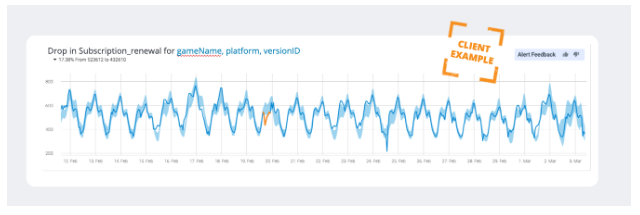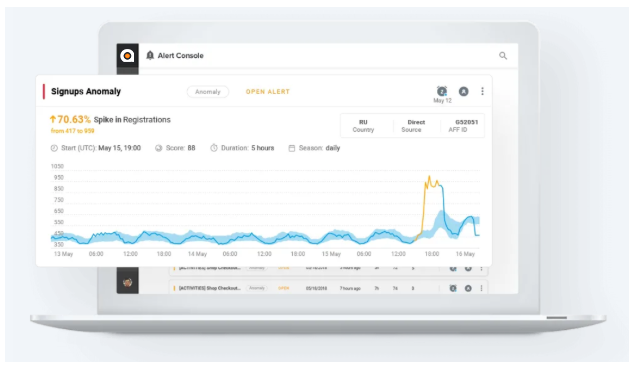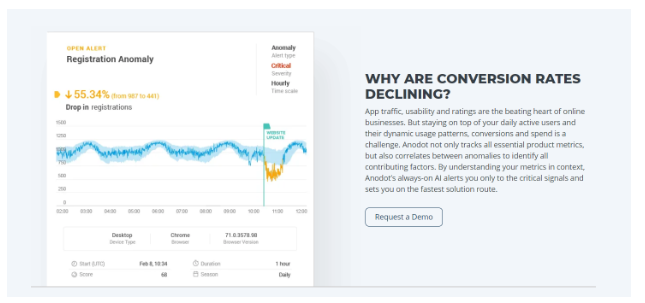While single transaction revenue models are prone to fluctuate based on the seasonality of markets, subscription plans offer more predictable revenues.
And while that consistency can certainly be advantageous over one-off transactions, it’s notoriously challenging to keep subscribers active.
The cornerstone to managing and scaling a subscription-based business is monitoring the KPIs that influence top-line revenue, such as:
- conversion rate
- churn rate
- retention rate
One of Anodot’s customers runs a subscription-based business with transactions from various countries, in different languages and on different devices. Before working with Anodot, the company experienced an error in the customer sign-up process, where the SMS verification was broken— but only for customers in Russia using Android devices.
Without this SMS verification process in place, anybody that fell into this demographic was unable to subscribe to their subscription or process their payment for three weeks.
Instead of being able to detect this anomaly in real-time, the bug went unnoticed by their traditional monitoring methods, resulting in three weeks of frustrated customers and hundreds of thousands in lost revenue.
As soon as they realized how much time and money could have been saved with the use of machine learning, the company immediately went looking for an AI-based revenue monitoring solution.
While you can theoretically use traditional monitoring methods such as statistical models or BI tools, they lack the granularity, scalability, and accuracy to be able to find and alert on an anomaly like the one described above.
What is Revenue Monitoring?
If you’re running a subscription-based business, you know that you need to constantly monitor performance metrics such as website traffic, bounce rate, time on site, and many others.
The same concept applies to revenue data.
Revenue monitoring refers to the process of tracking the KPIs and metrics that influence overall revenue such as conversion rate, subscriber growth, subscribers per location, and so on.
Revenue data is often made up of billions of data points that are influenced by human behavior.
In particular, as discussed in our white paper on business monitoring, these metrics pose a unique challenge for three main reasons:
- Context: Revenue-related business metrics often can’t be evaluated in absolute terms, with set maximum and minimum thresholds. They should be evaluated in relation to a set of changing conditions.
- Topology: It’s much easier to track the relationship between different machines, although the same is not true for business metrics. The relationships and correlations between metrics are dynamic and volatile.
- Volatility: Business metrics often have irregular sampling rates, which requires a significant adaptation of how data is stored and how the algorithms work.
Due to the dynamic nature of revenue-related metrics, manually monitoring that data manually or with static thresholds can easily deluge teams with false positives or, worse yet, allow for false negatives to go unnoticed.
So how can companies overcome current hurdles to scalable monitoring and ensure the consistency and predictability of their revenue?
Many companies are enhancing their analytics stack with machine learning, automating their monitoring and anomaly detection.
Applying AI to Revenue Monitoring
AI-based revenue monitoring means that the solution is able to learn the usual behavior of each performance metric on its own, without providing static thresholds.
Machine learning’s ability to process huge amounts of data and derive insights, patterns, and correlations means that it can provide the granularity and scalability that subscription-based businesses need to effectively monitor their revenue. The AI-based solution can then notify the appropriate team in real-time when anomalous events do occur.
Returning to our earlier example of monitoring location-based changes in subscription renewals, below is a visualization of how AI-based anomaly detection can be used for revenue monitoring. In particular, we can see the model is monitoring active subscribers of a particular plan for a given location:
In this example, we can see that the blue line is the actual users’ behavior, and the shaded blue area is the expected behavior based on what the machine learning algorithm has previously learned.
This is an example of unsupervised learning in which the machine learning algorithms derive patterns and structure from unlabeled data. As an example, Anodot uses sequential adaptive learning to learn the normal behavior of each metric, and then each new data point is computed in relation to this behavior going forward.
If, however, we wanted to add more metrics to monitor such as each individual traffic source, referrals from affiliates, and so on, you can see how this would simply be too complex for a traditional BI tool to monitor.
As highlighted in our guide on Revenue Monitoring with AI, a few reasons why an AI-based solution has so advantageous over traditional monitoring include:
- AI can learn and monitor each revenue stream by itself: Since the revenue streams from each subscription plan are unique, this means it’s crucial to monitor each one on its own instead of simply monitoring revenue as a single metric.
- AI can monitor metrics such as traffic and conversion rates simultaneously: If an anomalous event does occur, for example, a significant drop in revenue, being able to monitor not only top-line revenue but also the events that lead up a purchase (such as traffic, conversion rates, etc.) means that you can immediately identify the root cause.
- AI can correlate metrics and events in real-time for the shortest time to resolution: In the same way that AI can monitor multiple metrics simultaneously, it can also find correlations between metrics and events so that you know exactly what is causing the anomaly and so you have the shortest time to resolution possible.
Real World Examples of Revenue Monitoring for Subscription-Based Businesses
These are among the most common revenue-related metrics to monitor in a subscription business model.
Churn Rate Monitoring
Churn rate helps you identify how many customers you’re losing over a given time period. Monitoring this metric is one example of leveraging customer experience monitoring for subscription-based businesses as a high churn rate indicates that users either aren’t getting enough value from the subscription or don’t know how to use the product properly.
New Subscriber Monitoring
New subscriber monitoring is another use case of AI-based revenue monitoring. As you can see below, the anomaly detection solution is constantly monitoring for spikes or drops in registrations. The platform is also fully autonomous so you don’t need to set up and update typical subscriber thresholds. This means that the AI can autonomously monitor billions of events and distills them into a single score, and can also send impact alerts when you need them most.
Conversion Rate Monitoring
Conversion rate is another metric that has a high impact on a company’s revenue. If there is a sudden drop in conversion rate, this could mean that there is something broken on the website, or, like the example mentioned earlier, there could be a simple translation error. Catching these issues in real-time can often lead to saving a significant amount of potential lost revenue.
Aside from conversion rate monitoring for purchase conversions, as discussed in our guide on Use Cases for Machine Learning, subscription-based businesses can also monitor existing customers from the time they login until the time they logout. This allows you to identify anomalous user behavior such as how they’re interacting with features in the product
Revenue Monitoring for Subscription-Based Businesses
As we’ve discussed, revenue streams for subscription-based businesses are highly complex and often fragmented across products, plans, and locations. These revenue streams are also highly susceptible to changes in things like conversion rate, churn rate, and many other performance metrics.
The dynamic nature of this revenue data means that traditional monitoring methods, such as BI tools, simply don’t offer the capabilities that are required.
Instead, an AI-based anomaly detection solution can learn the usual behavior of each individual metric on its own, and provide real-time updates when it matters most.
Regardless of the number of products offered or the number of active subscribers, being able to catch these incidents in real time can often mean saving a significant amount of otherwise lost revenue.








